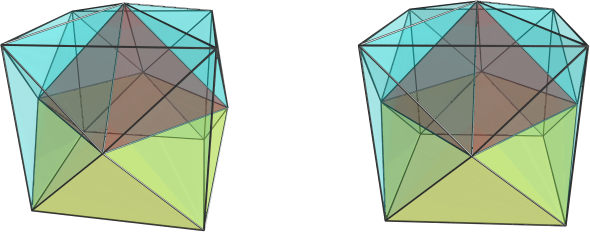quickfur wrote:Conjecture (almost certainly a theorem, but I don't have a proof): in any dimension n, (n-1)-simplex || (n-1)-simplex = n-cross.
Proof is rather easy. First we note that any (n-1)-simplex (with edge-length sqrt(2)) can be given n-coordinats as follows: (1,0,0,...) (0,1,0,...) (0,0,1,...) etc.
Furthermore any n-cross-polytope can be given coordinates (1,0,0,...) (-1,0,0,...) (0,1,0,...) (0,-1,0,...) (0,0,1,...) (0,0,-1,...) etc.
These can be divided into two sets of coordinates, namely the positives ( (1,0,0,...) (0,1,0,...) (0,0,1,...) etc.) and the negatives ( (-1,0,0,...) (0,-1,0,...) (0,0,-1,...) etc. )
These are the coordinates of two simpices in dual orientation.
If you want me to prove that they are in dual orientation, here i go:
The middles of the simplices have coordinates (1/n,1/n,1/n,...) and respectively (-1/n,-1/n,-1/n,...). If we want to make them origin-centered, we have to subtract these vectors, and we get (n-1/n,-1/n,-1/n,...) (-1/n,n-1/n,-1/n,...) (-1/n,-1/n,n-1/n,...) and respectively (-(n-1/n),1/n,1/n,...) (1/n,-(n-1/n),1/n,...) (1/n,1/n,-(n-1/n),...). First we note that a vertex of a simplex is always opposite to the middle of a facet, thus the coordinates of a vertex of a origin-centered simplex multiplied with a specific negative constant n, gives the middle of a facet. If we scale one simplex down with some positive constant p, and it's vertices lie in the middle of the facets of the other simplex, we've proven that they're in dual orientation. And it's easily seen that if we choose p to be -n^-1, n*p*(n-1/n,-1/n,-1/n,...)= (-(n-1/n),1/n,1/n,...), and for all the other vertices a similar procedure can be followed, which means it is proven.
EDIT: middle coordinates of simplex corrected


 I was looking for 4p || 4pyr and didn't think to look at the gyro entries as well. Thanks!
I was looking for 4p || 4pyr and didn't think to look at the gyro entries as well. Thanks!